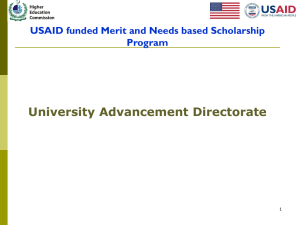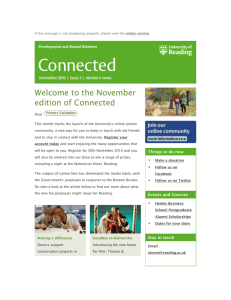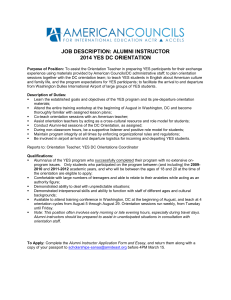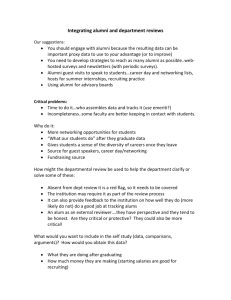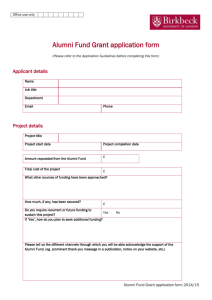pre-entry - University of Washington
advertisement
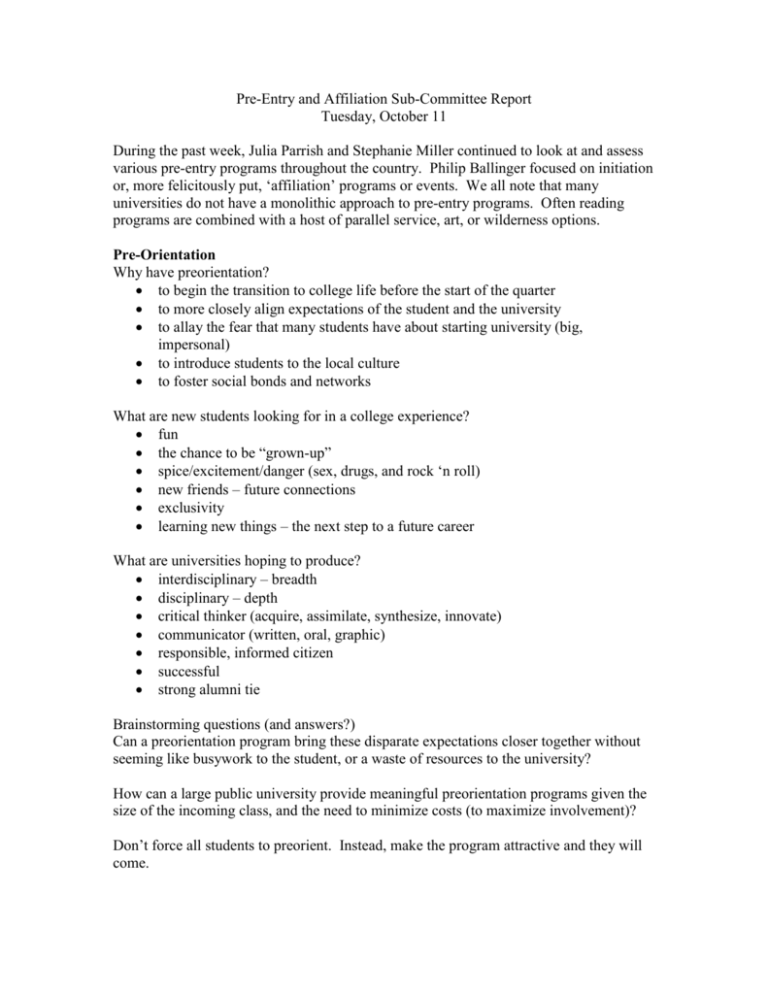
Pre-Entry and Affiliation Sub-Committee Report Tuesday, October 11 During the past week, Julia Parrish and Stephanie Miller continued to look at and assess various pre-entry programs throughout the country. Philip Ballinger focused on initiation or, more felicitously put, ‘affiliation’ programs or events. We all note that many universities do not have a monolithic approach to pre-entry programs. Often reading programs are combined with a host of parallel service, art, or wilderness options. Pre-Orientation Why have preorientation? to begin the transition to college life before the start of the quarter to more closely align expectations of the student and the university to allay the fear that many students have about starting university (big, impersonal) to introduce students to the local culture to foster social bonds and networks What are new students looking for in a college experience? fun the chance to be “grown-up” spice/excitement/danger (sex, drugs, and rock ‘n roll) new friends – future connections exclusivity learning new things – the next step to a future career What are universities hoping to produce? interdisciplinary – breadth disciplinary – depth critical thinker (acquire, assimilate, synthesize, innovate) communicator (written, oral, graphic) responsible, informed citizen successful strong alumni tie Brainstorming questions (and answers?) Can a preorientation program bring these disparate expectations closer together without seeming like busywork to the student, or a waste of resources to the university? How can a large public university provide meaningful preorientation programs given the size of the incoming class, and the need to minimize costs (to maximize involvement)? Don’t force all students to preorient. Instead, make the program attractive and they will come. Don’t create a one-size-fits-all program. Students are individuals, allow them to stay that way. Don’t separate students by cultural background/experience. But DO, choose a set of themes that interweave among the preorientation options. Make the themes regional, cutting edge, and unique to the UW. Natural resources, sustainability, technology, and environmental justice come to mind. How about “Green by Design”? DO connect the preorientation program more directly with the programs extant at the UW: faculty research, field stations or other off-site facilities. DO strengthen ties with alumni: showcase successful graduates from the UW such that the student can see a path from their current position (starting university) to a future career. What other universities have done Passive Programs – students engage as individuals, without leaving home. Summer Reading Programs Explanation: Students read one or more selections during the summer, and discuss the readings once they arrive on campus. Some universities focus on a single book, usually fiction but not always (eg. Smith – Kettle Bottom; Duke – Kite Runner). Occasionally, the book is sent to all students in an information/orientation packet. The author of the book may be invited to campus to give a lecture at orientation, or the beginning of the term (eg. Smith, Duke). The reading(s) may be taken up by a range of freshmen classes (eg. Slippery Rock – Nickel and Dimed; Berkeley – diverse reading packet chosen by faculty teaching those classes). Finally, the reading(s) may demonstrate a theme that the university wishes to identify with (eg. Slippery Rock – economics and social justice using the book Nickel and Dimed). Up Side: Inexpensive. The cost of a paperback is minimal to the student. Down Side: Ineffectual. All conversations I had with students (from UW as well as campuses currently providing summer reading programs) indicated that the students regard summer reading with at least suspicion, and at most derision. Some students told me that summer reading did create student bonding, but against the ‘inept adult’ culture of the university. How might summer reading be harnessed at UW? Don’t require it. Students who are readers are more likely to take advantage of the opportunity. Allow these students to self-select. Connect the reading directly to the UW and/or to the future majors/careers of the students. Provide exclusivity and social bonding. Create a discussion/interaction at orientation that demonstrates to these students that they are special, and that they can depend on each other. Consider other types of readings than published fiction/nonfiction. What about the internet? What about blogs? Active Programs – students are physically involved in an activity with other students. Outdoor Experience Explanation: Students have a 3-14 day structured ‘wilderness’ experience shared with future classmates and upper classmen. Low key versions of the experience are reminiscent of summer camp – many students congregate at a camp facility, marshmallows are roasted, etc. (eg. CampBuckeye at Ohio State; Yale FrechPerson Conference). Many smaller universities (eg Princeton, Cornell, University of Pennsylvania, Skidmore, Smith, Yale) provide a range of small group camping experiences that may include additional activities (and be marketed as such), including rock climbing, rafting, and canoeing. Students bond with each other, and with the upperclassmen (usually a 1:5-6 ratio) trip leaders. Evening discussions centered on university life are scheduled, but in a low key way. A few universities offer outwardbound type trips that bond students through shared wilderness survival experiences (eg. Colorado College). Some universities attempt to link a wilderness experience with a larger issue, such as sustainability or conservation (eg. Yale’s HARVEST program takes students to an organic farm; Skidmore’s Environmental Studies program takes students hiking while learning about sustainability). Up Side: Definitely accomplishes social bonding, allays incoming fears, and begins to align expectations between the students and the university. Students who have done these trips largely rave about them, and these positive reviews are used by the universities to recruit students for the next year. Aligning a popular outdoor experience with a larger set of issues that may pervade, and even define, a particular campus is attractive. Down Side: Expensive. Trips prices ranged from $50 (2 day, summer camp-type experience) to $500 (10-14 day outback camping). All consuming logistics – for a small school, a majority of the students can participate (half of the incoming Princeton class participates in the “Frosh Trip”). For a large school such as UW, this is just not possible. How might outdoor experiences be harnessed at UW? Create a central set of themes that are relevant to the Northwest, to the UW, and to the incoming students. Sustainability, experiencing the natural environment, and conservation are a few. Link trips to ongoing faculty research programs in a UW “EarthWatch” fashion. Link trips to UW research facilities (eg. Friday Harbor Labs, Olympic Natural Resource Center). Link trips to facilities of likely long-term partners (eg. Cedar River Visitors Center – City of Seattle, Mt. Saint Helens Visitors Center, national parks, Olympic Coast National Marine Sanctuary). Link trips to regional manufacturers that have mission statements that echo the central themes (eg. REI, Patagonia for sustainability). Perhaps these manufacturers could also be asked to contribute to defraying the expenses of the poorer students – an outdoor experience scholarship fund. Volunteer Experience Explanation: Students come to campus and spend 2-10 days working in various community action and volunteer programs, usually based within the city that houses the university. Everything from manning soup kitchens to Habitat for Humanity (a favorite) and planting city gardens. Trips often have religious or social justice overtones. Occasionally students learn about volunteer activities rather than actually volunteering (eg. Skidmore). Some of the most progressive programs place students in a wide range of community action organizations (eg. Colorado College BreakOut Program partners with 36 different agencies from Colorado Springs to Denver). During the evenings, student volunteers meet and talk with leader upperclassmen about their volunteer experience, the large community, and the university community. Up Side: Definitely creates a bond among the students, and may also foster future community service and interaction among the students. At the very least, a powerful amount of work can be accomplished, if the students are well supervised. Not as expensive as the outdoor experience, presumably because the students are staying in dorms, but still a large cost ($50-$250) over reading programs. Down Side: A logistical issue similar to the Outdoor Experience. If not well managed, students do not get the feeling that they are helping, and agencies spend too much of their precious staff time training student volunteers for the short-term. How might volunteer experiences be harnessed at UW? Create a central set of themes that are relevant to the Northwest, to the UW, and to the incoming students. Sustainability, experiencing the natural environment, and conservation are a few. These themes could/should pervade pre-orientation, and set the UW apart in its preorientation. Partner with Seattle, which has announced various sustainability events and city themes. On-Campus Experience Explanation: Students spend 2-5 days on campus meeting with upperclassmen leaders in a themed look at the university. Students may also connect with select faculty and/or university staff. Most of these programs center around Arts and Humanities (eg. Skidmore’s Tabula Rasa Art, Behinds the Scenes at the Tang). Occasionally programs seem to target students of color (eg. Smith’s and Yale’s Cultural Connections). A few programs target introspective inquiry balanced with physical activity, usually yoga (eg. Smith’s and Skidmore’s Inward Bound). Up Side: Relatively inexpensive ($50-$250). Students get to familiarize themselves with a portion of campus and campus life, and can begin to link to faculty and staff they may encounter as they move towards a major. Down Side: Not really a downside here, except perhaps the observation that the programs for students of color seem (to me) to segregate rather than integrate. How might on-campus experiences be harnessed at UW? The on-campus experiences I found at other universities could be greatly expanded such that they: linked to future majors linked to future employers linked the UW to regional alumni Allowing students to telescope through their incipient UW experience all the way through to a successful career track embodied by one or more alumni seems like a sure bet. Why not have future architecture students visit major buildings in the region and meet local architects (David Miller comes to mind)? How about future engineers and Boeing, or computer scientists and Microsoft? How about forestry students and Weyerhauser? One institution that takes a multi-layered approach is Ohio State University. Philip spoke with Dr. Mabel Freeman, the OSU Asst. VP for Undergraduate Admissions and First Year Experience. Mabel also sent an informative email with a useful web link. Here is the email: Hi Phil: Since my office is responsible for both undergraduate admissions AND the first year experience, this is exactly what we are all about. We have responsibility for being the catalyst (and implementer in many cases) at the university for transition programs, the traditional Orientation in the summer, programs before school begins, special programming during the first week to make sure that 5800 freshmen have a sense of community, tradition, and connectedness to the university, and then various programs in the first year to continue this sense of being a community. While increasing retention is significantly because of the improving quality of the entering class, we really believe that a good part of the increase is also about taking better care of our first year students, even when there are close to 6000 of them. In the past ten years we have gone from 79% to 89% first year retention. Examples of what we have started include: a. Buckeye Book Community: we have a grant that allows us to purchase the summer reading book for every freshman and distribute them at summer Orientation; we actually have four different books because the colleges get together and decide what they want their particular students to read so that they can then follow up in the fall with special programming about the particular selection b. Camp Buckeye: Just started this summer. Since we are on the quarter system and begin so late (after everyone’s friends have left for college) students can choose to participate in a late August two day camping program to get to meet other entering freshmen and a few faculty and staff who go along. We started with about 40 students this year. c. Leadership Collaborative: Another pre-fall program started with a grant to bring in 55 freshmen for four days for a conference on Leadership and Ethics. d. Convocation: Our students move into the residence halls on Sunday but regular classes do not begin until Wednesday. The only class that meets before that is the student’s required University Survey course on Monday morning. Following the meeting of that class, the academic advisor who teaches the class walks his/her students to St. John Arena. We get all of the freshmen that way for the Convocation. When they walk in the arena, a video is playing of all different groups of staff, students, faculty on campus giving them different types of welcome as well as alumni from all different parts of the world, etc. We have the traditional academic procession of the president, deans, distinguished faculty, etc. but as they march in, each one is introduced and shown on a giant screen so that students can identify the particular dean/faculty of their college. The entire marching band is in the arena. In addition to speeches from the president, a member of the faculty, the leader of student government, etc, the Orientation student leaders from the summer (all the freshmen should be able to pick out their leader since the leader did follow up postcards in the summer to each of the students in their groups) then teach the students the words and music to our alma mater..with the help of the band. I get to speak to the students and in my remarks I have the students open bags that they were given as they entered the arena (we get special bags printed and donated by the OSU Alumni Association with the statement “Successful Buckeye Alumni Have Successful First-Year Experiences.” In the bags are many items and pieces of information. We give every student a disposable camera with scenes of Ohio State on the cardboard exterior. I then have the students exchange cameras with the person next to them and on the count of 3 take the person’s picture and then I count to 3 again and the other person takes the picture of the first student. The flash bulbs going off in the arena always elicits lots of ooohhs! The students then return the cameras to each other. I point out to them that they are to use this particular camera to take pictures for the first week of “their university; their new friends; their new community” and the first picture on their camera is each of them at Convocation. I also have them pin on a Block O pin that is in the bag and I always kid some of the “macho guys” that we will wait until I see them pinning on that pin. Perhaps most importantly in that bag is a scarlet and grey mortarboard tassel. I explain to them that when they graduate they will be wearing tassels that represent the colors of their particular college. This scarlet and grey tassel is to be their constant reminder over the next four or so years as to why they have come to the university….to graduate from Ohio State. I encourage them to hang these tassels on a mirror, on their computer, on their bedpost, on a lamp…someplace where they will see them frequently. (when I make visits during the year into the dorms I am always amazed at how many of these tassels I see everywhere) We always have one last “surprise speaker” at Convocation and students are now beginning to hear about that and speculating as to who it might be each year. Obviously we want it to be someone whose name they recognize and who has a connection with the university….which means typically one of our famous athletes. The faculty has resigned themselves to the fact that usually this athlete/alum gets more applause than they do! Now, if you are still reading this, for the truly symbolic conclusion, the arena is across the street from our football stadium. We hold graduation in the football stadium. The marching band followed by the President and the deans leads the students across the street and down the entrance ramp onto the field. When the students walk in, they can look up at the giant scoreboard on the other end and see themselves on the big video screen. We tell them that they should picture themselves walking into the stadium four years later. From the stadium they then walk over to our Oval where the President’s picnic and Student Involvement Fair is taking place for them. e. If you visit our fye website http://fye.osu.edu you will find a number of other programs we are doing with first year students, including our First Year Success Series, more than 300 seminars in the fall quarter on issues of transition and success, etc. Students are required as part of their survey course to attend anywhere from 2 to 5 of these programs during the quarter with the student getting to choose the ones he/she wants to attend. As you can tell from the length of this email, this is one of my favorite topics. If I can be of further help, just call or email. We really believe that large universities can have a sense of community for their students. Mabel Mabel G. Freeman, Ph.D. Assistant Vice President Undergraduate Admissions and First Year Experience The Ohio State University 110 Enarson Hall 154 West 12th Avenue Columbus, Ohio 43210 Phone: 614.247.6281 Fax: 614.688.3226 In conversation with Mabel, Philip learned more about OSU’s convocation event. Apparently it is memorable; the students note it even after their graduation from OSU – quote: “It makes them feel that they really belong at OSU.” OSU spends approximately $25,000 on the convocation; additionally, their alumni association funds the ‘gifts’. It is the main affiliation event at the beginning of the year. OSU’s First Year Success Seminars are also interesting. Philip also interviewed the UW First Year Program staff and will submit a bulleted summary. Interviews with Christine Ingebritsen and the Student Affairs division directors have also been scheduled. Philip Ballinger Director of Admissions University of Washington

